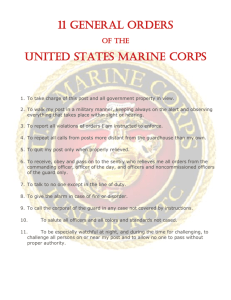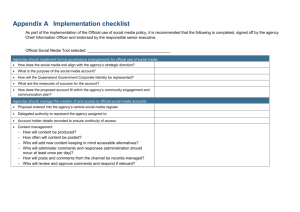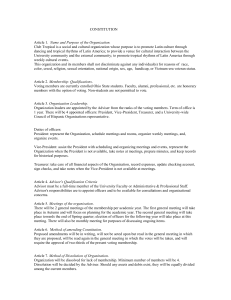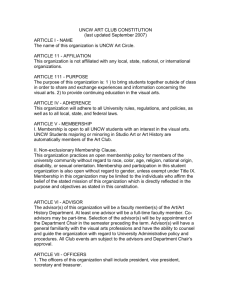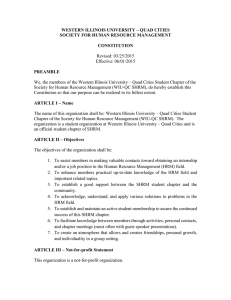Financial Problems
advertisement
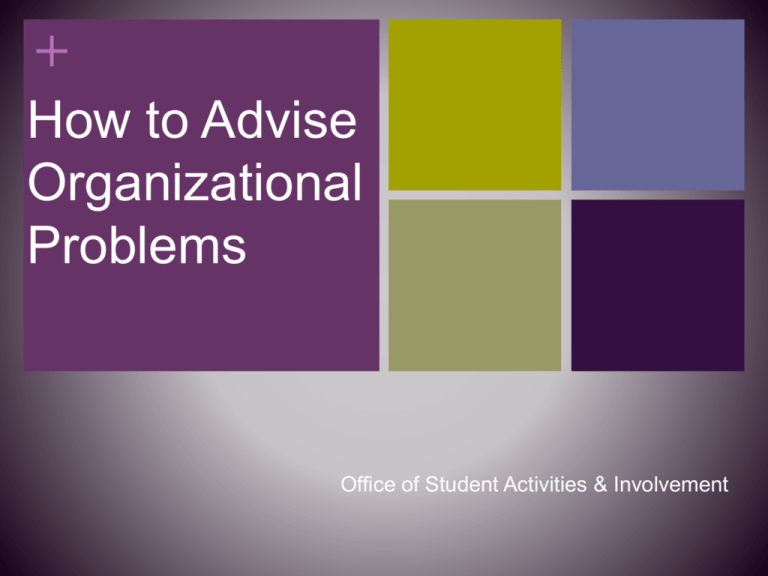
+ How to Advise Organizational Problems Office of Student Activities & Involvement Before Approaching the Situation When there is an organizational problem, it doesn’t necessarily mean that the advisor has to be the one to confront the situation. Whenever possible, try to help students who notice a problem solve it on their own. Guiding students to take on their own conflicts will greatly benefit their effectiveness as a student and professional leader. Share possible ways to approach the situation and provide tools to help them through the situation. If the confrontation is unsuccessful and the conflict is intruding on organization principles, procedures, and group morale then the advisor should step in. Top 10 Communication Tips 1. Listen Carefully & Think Before Speaking 8. Encourage Others to Communicate 2. Discuss Positive Feelings 9. Respond Positively to Constructive Criticism 3. Use Good Timing 10. Be Honest 4. Consider Other’s Needs 5. Use “I” Messages 6. Speak Clearly & Specifically 7. Be Open-Minded Common Organizational Problems Meetings are disorganized Meetings are too long The organization suffers from financial problems There is no continuity from one year to the next; officers do not transition smoothly The organization has no "plan of action” No historical context Disorganized Meetings If meetings are disorganized: Have the leaders read the “Running Effective Meetings” module for guidance. Have goals for the meeting been identified? Has necessary background information been reviewed? Are expectations for member’s contributions clear? Has the sequence of events for the meeting been previewed? Have time constraints been identified? Meetings are Too Long If meetings are too long: Have the leaders read the “Running Effective Meetings” module for guidance. If the organization is already following the module, consider the following: Email the meeting agenda to the group so they can read it in advance. Don’t let officers repeat what is already on the agenda. In discussion, avoid repeating. Designate a timekeeper for the meeting to start and end on time. Start with business that needs to be discussed ASAP, so that other business items can be saved for a different meeting if time runs out. Financial Problems If the organization suffers from financial problems: The treasurer, advisor, and other leaders should go through the organization budget and determine the issue. Prepare an outline of the organization’s planned activities for the coming year. Rank order by their relative importance, which activities are the largest expenditures of funds. Eliminate or limit less essential expenditures. Set and maintain a minimum cash balance. Keep an accurate log of financial transactions (income/expenses); maintain in a record book (check and balance records regularly). No Continuity or Officer Transition If there is no continuity from one year to the next: The current officers should begin planning an officer transition plan. Officer transition is one of the most important events in a student organization's year. Smooth and effective transitions will allow for a quick and effective start to the annual organizational cycle. It is recommended that a transition meeting be conducted before the new officers assume their positions and before the old officers leave the campus. As the advisor, you should participate to help the continuity between new and old officers. Some groups hold elections early and have officer “elects”, who will shadow the current officer until their term ends. This assists in the transfer of information from one officer to the next. No Plan of Action If the organization has no “plan of action:” Review the mission and purpose with the officers. Express a sincere interest in the group and its mission. Stress the importance of each individual’s contribution to the whole. Assist the group in setting realistic, attainable goals. Ensure beginning success as much as possible, but allow the responsibility and implementation of events to lie primarily with the organization. No Historical Context Many organizations encounter problems because there is a lack of understanding of why the organization exists, what its mission was and is, how the organization has been influenced by internal and external factors over the years, and the importance of the group from a “big picture” perspective. Encourage the organization to research its origin. Pay a visit to the Office of Student Activities and Involvement and ask to see what information is on file for the group. Research any local, regional, or inter/national affiliated programs to see how they are similar or different than this chapter’s. Contact Information Office of Student Activities & Involvement 285 Warren Service Drive MSC 3501 Harrisonburg, VA 22807 (540)568-8157 beinvolved@jmu.edu www.info.jmu.edu/osai


